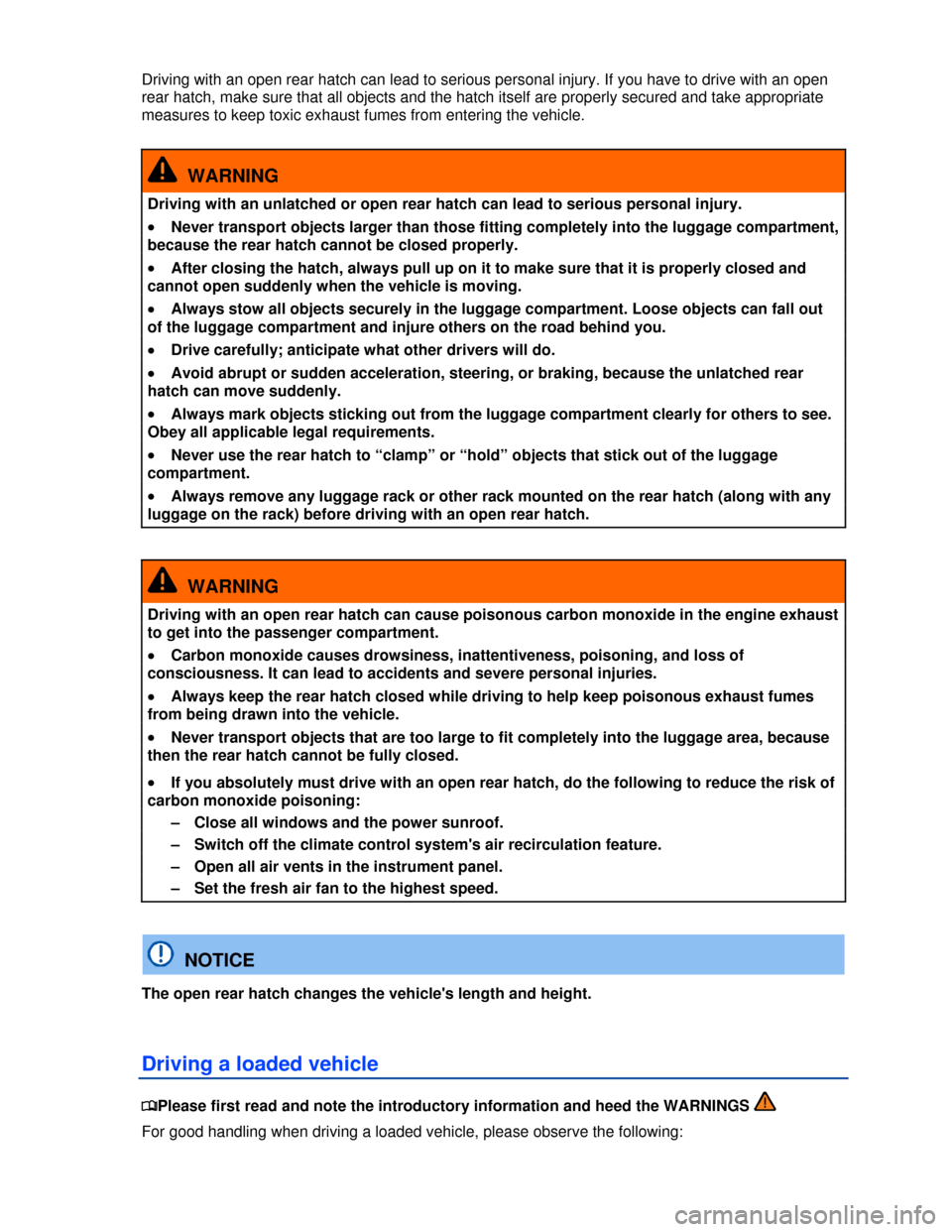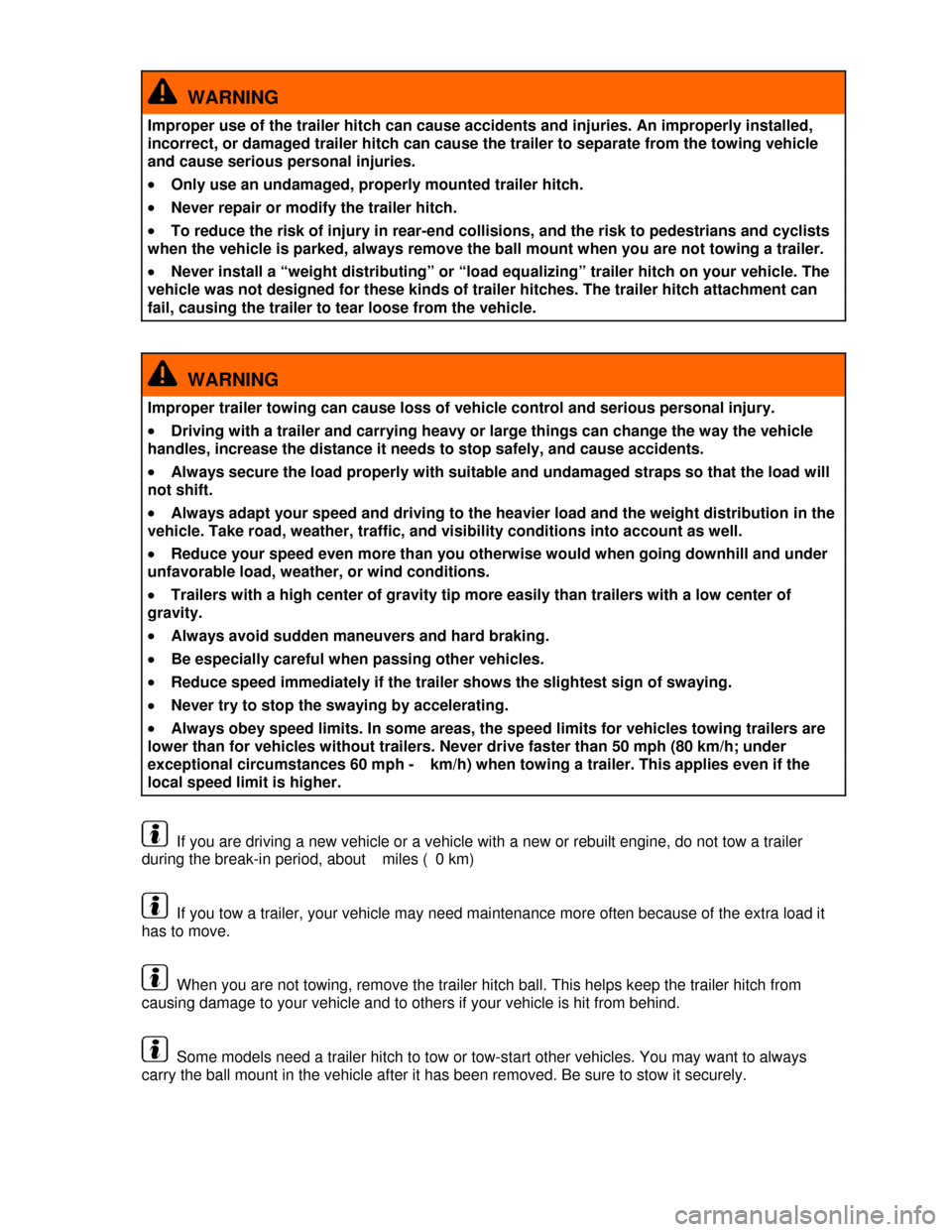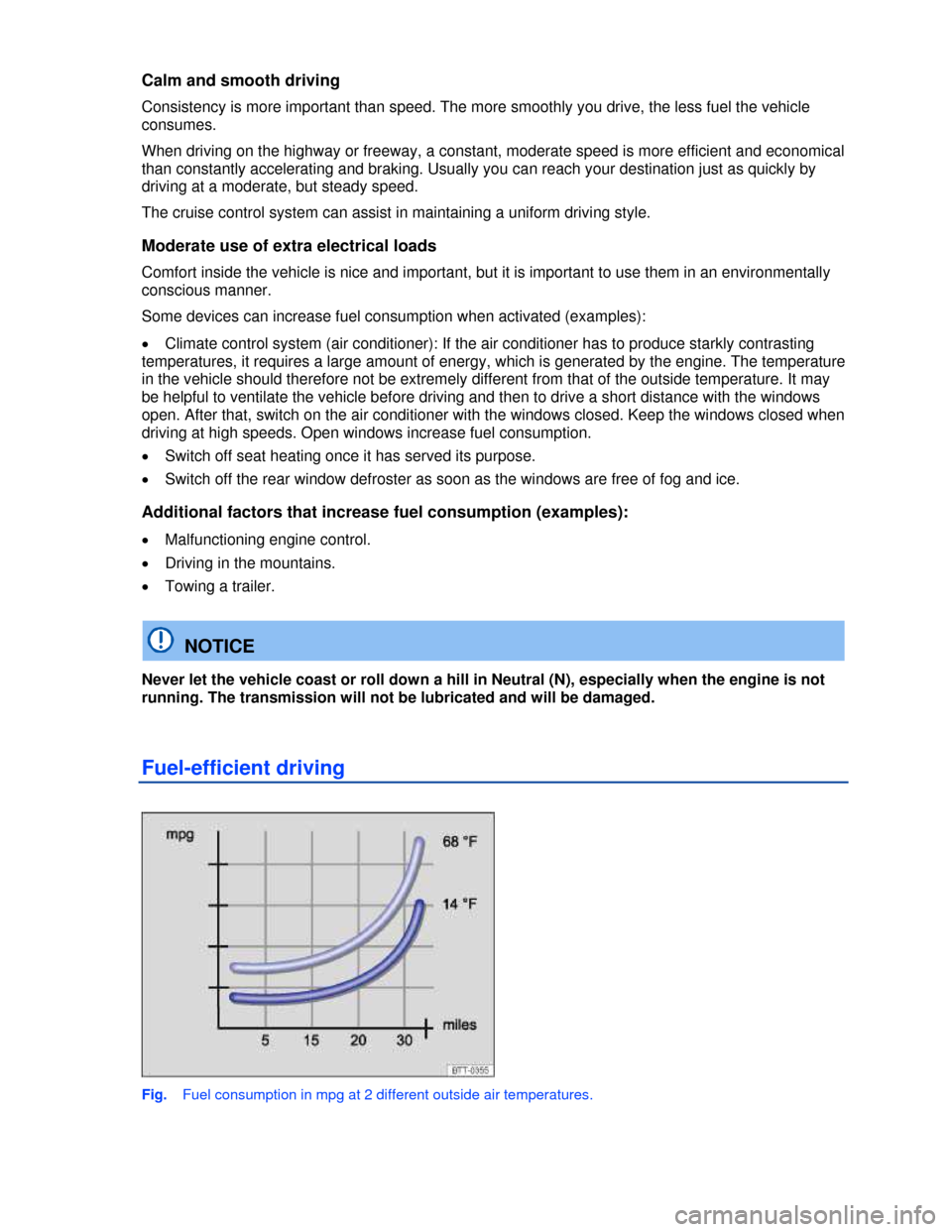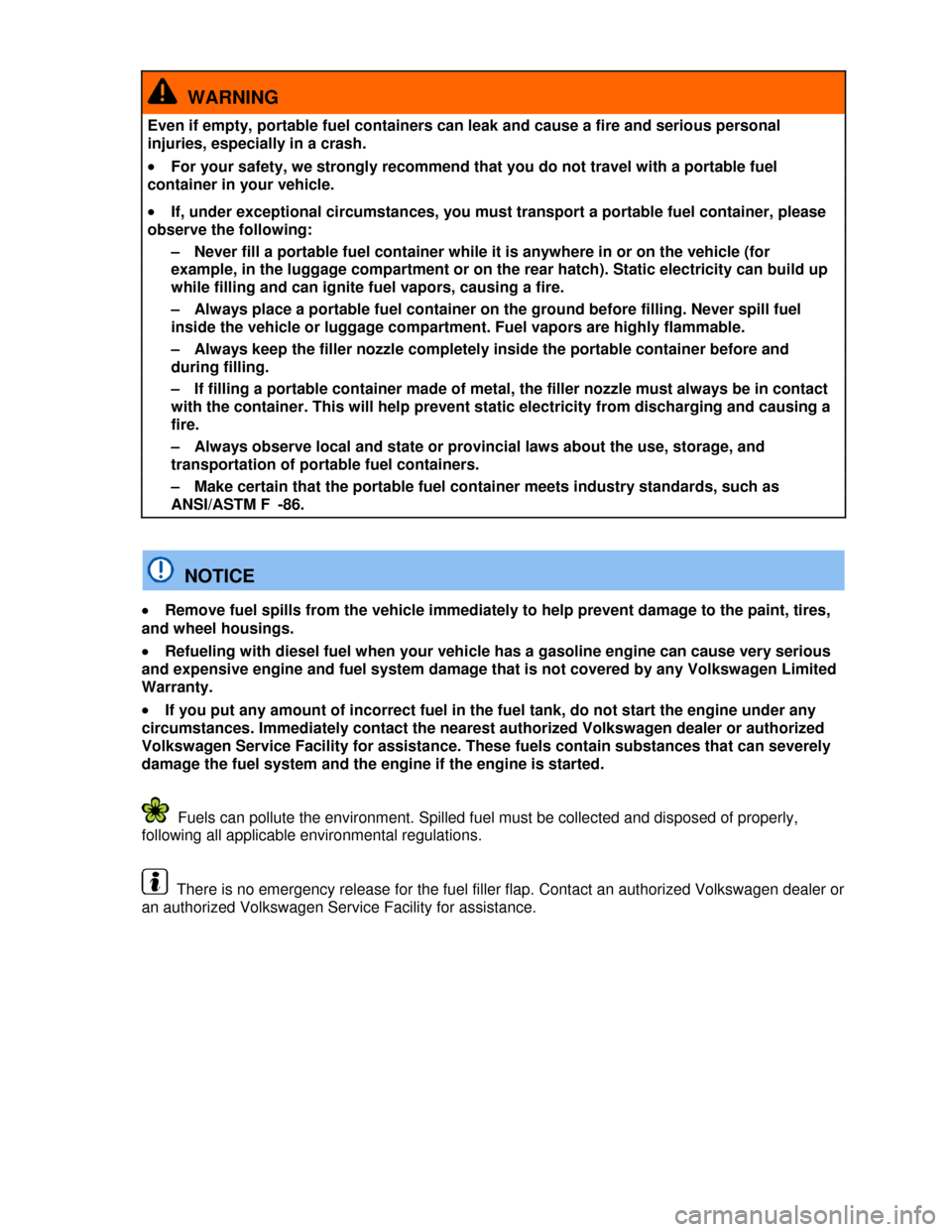2013 VOLKSWAGEN TIGUAN engine mount
[x] Cancel search: engine mountPage 123 of 356

Driving with an open rear hatch can lead to serious personal injury. If you have to drive with an open
rear hatch, make sure that all objects and the hatch itself are properly secured and take appropriate
measures to keep toxic exhaust fumes from entering the vehicle.
WARNING
Driving with an unlatched or open rear hatch can lead to serious personal injury.
�x Never transport objects larger than those fitting completely into the luggage compartment,
because the rear hatch cannot be closed properly.
�x After closing the hatch, always pull up on it to make sure that it is properly closed and
cannot open suddenly when the vehicle is moving.
�x Always stow all objects securely in the luggage compartment. Loose objects can fall out
of the luggage compartment and injure others on the road behind you.
�x Drive carefully; anticipate what other drivers will do.
�x Avoid abrupt or sudden acceleration, steering, or braking, because the unlatched rear
hatch can move suddenly.
�x Always mark objects sticking out from the luggage compartment clearly for others to see.
Obey all applicable legal requirements.
�x Never use the rear hatch to “clamp” or “hold” objects that stick out of the luggage
compartment.
�x Always remove any luggage rack or other rack mounted on the rear hatch (along with any
luggage on the rack) before driving with an open rear hatch.
WARNING
Driving with an open rear hatch can cause poisonous carbon monoxide in the engine exhaust
to get into the passenger compartment.
�x Carbon monoxide causes drowsiness, inattentiveness, poisoning, and loss of
consciousness. It can lead to accidents and severe personal injuries.
�x Always keep the rear hatch closed while driving to help keep poisonous exhaust fumes
from being drawn into the vehicle.
�x Never transport objects that are too large to fit completely into the luggage area, because
then the rear hatch cannot be fully closed.
�x If you absolutely must drive with an open rear hatch, do the following to reduce the risk of
carbon monoxide poisoning:
– Close all windows and the power sunroof.
– Switch off the climate control system's air recirculation feature.
– Open all air vents in the instrument panel.
– Set the fresh air fan to the highest speed.
NOTICE
The open rear hatch changes the vehicle's length and height.
Driving a loaded vehicle
�
Page 142 of 356

WARNING
Improper use of the trailer hitch can cause accidents and injuries. An improperly installed,
incorrect, or damaged trailer hitch can cause the trailer to separate from the towing vehicle
and cause serious personal injuries.
�x Only use an undamaged, properly mounted trailer hitch.
�x Never repair or modify the trailer hitch.
�x To reduce the risk of injury in rear-end collisions, and the risk to pedestrians and cyclists
when the vehicle is parked, always remove the ball mount when you are not towing a trailer.
�x Never install a “weight distributing” or “load equalizing” trailer hitch on your vehicle. The
vehicle was not designed for these kinds of trailer hitches. The trailer hitch attachment can
fail, causing the trailer to tear loose from the vehicle.
WARNING
Improper trailer towing can cause loss of vehicle control and serious personal injury.
�x Driving with a trailer and carrying heavy or large things can change the way the vehicle
handles, increase the distance it needs to stop safely, and cause accidents.
�x Always secure the load properly with suitable and undamaged straps so that the load will
not shift.
�x Always adapt your speed and driving to the heavier load and the weight distribution in the
vehicle. Take road, weather, traffic, and visibility conditions into account as well.
�x Reduce your speed even more than you otherwise would when going downhill and under
unfavorable load, weather, or wind conditions.
�x Trailers with a high center of gravity tip more easily than trailers with a low center of
gravity.
�x Always avoid sudden maneuvers and hard braking.
�x Be especially careful when passing other vehicles.
�x Reduce speed immediately if the trailer shows the slightest sign of swaying.
�x Never try to stop the swaying by accelerating.
�x Always obey speed limits. In some areas, the speed limits for vehicles towing trailers are
lower than for vehicles without trailers. Never drive faster than 50 mph (80 km/h; under
exceptional circumstances 60 mph - km/h) when towing a trailer. This applies even if the
local speed limit is higher.
If you are driving a new vehicle or a vehicle with a new or rebuilt engine, do not tow a trailer
during the break-in period, about miles ( 0 km)
If you tow a trailer, your vehicle may need maintenance more often because of the extra load it
has to move.
When you are not towing, remove the trailer hitch ball. This helps keep the trailer hitch from
causing damage to your vehicle and to others if your vehicle is hit from behind.
Some models need a trailer hitch to tow or tow-start other vehicles. You may want to always
carry the ball mount in the vehicle after it has been removed. Be sure to stow it securely.
Page 204 of 356

Calm and smooth driving
Consistency is more important than speed. The more smoothly you drive, the less fuel the vehicle
consumes.
When driving on the highway or freeway, a constant, moderate speed is more efficient and economical
than constantly accelerating and braking. Usually you can reach your destination just as quickly by
driving at a moderate, but steady speed.
The cruise control system can assist in maintaining a uniform driving style.
Moderate use of extra electrical loads
Comfort inside the vehicle is nice and important, but it is important to use them in an environmentally
conscious manner.
Some devices can increase fuel consumption when activated (examples):
�x Climate control system (air conditioner): If the air conditioner has to produce starkly contrasting
temperatures, it requires a large amount of energy, which is generated by the engine. The temperature
in the vehicle should therefore not be extremely different from that of the outside temperature. It may
be helpful to ventilate the vehicle before driving and then to drive a short distance with the windows
open. After that, switch on the air conditioner with the windows closed. Keep the windows closed when
driving at high speeds. Open windows increase fuel consumption.
�x Switch off seat heating once it has served its purpose.
�x Switch off the rear window defroster as soon as the windows are free of fog and ice.
Additional factors that increase fuel consumption (examples):
�x Malfunctioning engine control.
�x Driving in the mountains.
�x Towing a trailer.
NOTICE
Never let the vehicle coast or roll down a hill in Neutral (N), especially when the engine is not
running. The transmission will not be lubricated and will be damaged.
Fuel-efficient driving
Fig. Fuel consumption in mpg at 2 different outside air temperatures.
Page 242 of 356

WARNING
Even if empty, portable fuel containers can leak and cause a fire and serious personal
injuries, especially in a crash.
�x For your safety, we strongly recommend that you do not travel with a portable fuel
container in your vehicle.
�x If, under exceptional circumstances, you must transport a portable fuel container, please
observe the following:
– Never fill a portable fuel container while it is anywhere in or on the vehicle (for
example, in the luggage compartment or on the rear hatch). Static electricity can build up
while filling and can ignite fuel vapors, causing a fire.
– Always place a portable fuel container on the ground before filling. Never spill fuel
inside the vehicle or luggage compartment. Fuel vapors are highly flammable.
– Always keep the filler nozzle completely inside the portable container before and
during filling.
– If filling a portable container made of metal, the filler nozzle must always be in contact
with the container. This will help prevent static electricity from discharging and causing a
fire.
– Always observe local and state or provincial laws about the use, storage, and
transportation of portable fuel containers.
– Make certain that the portable fuel container meets industry standards, such as
ANSI/ASTM F -86.
NOTICE
�x Remove fuel spills from the vehicle immediately to help prevent damage to the paint, tires,
and wheel housings.
�x Refueling with diesel fuel when your vehicle has a gasoline engine can cause very serious
and expensive engine and fuel system damage that is not covered by any Volkswagen Limited
Warranty.
�x If you put any amount of incorrect fuel in the fuel tank, do not start the engine under any
circumstances. Immediately contact the nearest authorized Volkswagen dealer or authorized
Volkswagen Service Facility for assistance. These fuels contain substances that can severely
damage the fuel system and the engine if the engine is started.
Fuels can pollute the environment. Spilled fuel must be collected and disposed of properly,
following all applicable environmental regulations.
There is no emergency release for the fuel filler flap. Contact an authorized Volkswagen dealer or
an authorized Volkswagen Service Facility for assistance.
Page 323 of 356

Description Possible causes among
others Possible remedy
Tire pressure too low. Adjust tire pressure
Driving in the mountains. No direct corrective action possible.
Towing a trailer or driving with
a roof rack.
– Check use.
– Remove if not in use.
Driving with heavy payload. No direct corrective action possible.
Driving at high engine speed. Select a higher gear.